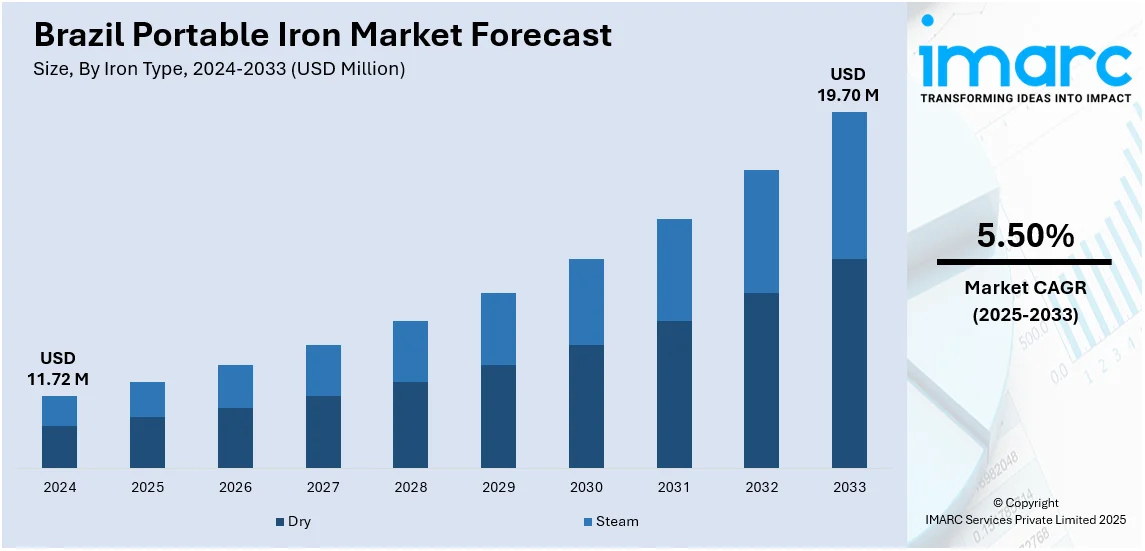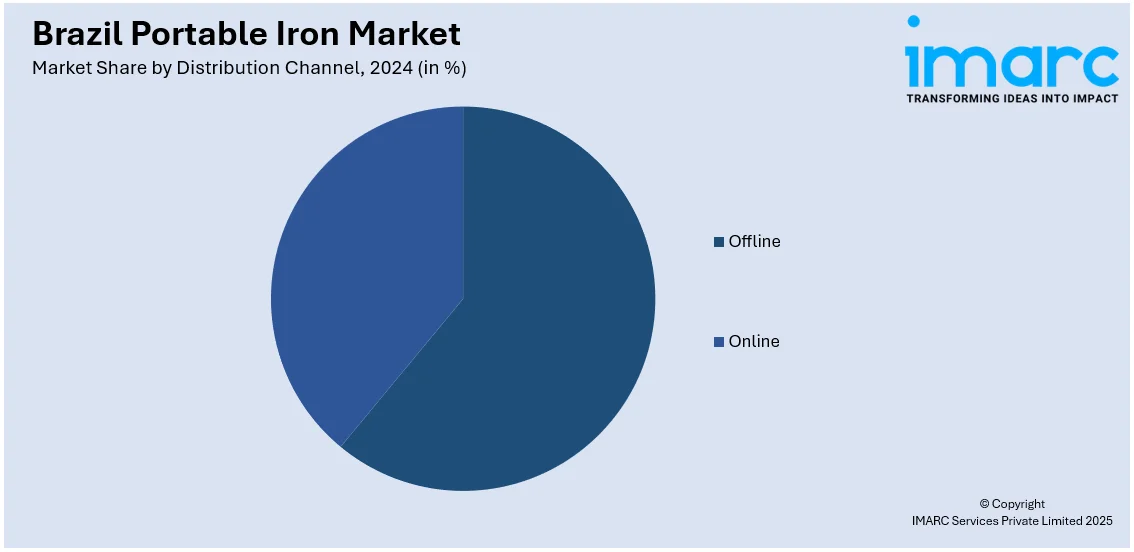
Brazil Portable Iron Market Size, Share, Trends and Forecast by Iron Type, Soleplate Type, Distribution Channel, and Region, 2025-2033
Brazil Portable Iron Market Overview:
The Brazil portable iron market size reached USD 11.72 Million in 2024. Looking forward, IMARC Group expects the market to reach USD 19.70 Million by 2033, exhibiting a growth rate (CAGR) of 5.50% during 2025-2033. The market is primarily driven by the increasing demand for convenient, travel-friendly appliances, rising disposable incomes, technological advancement, growing demand for home appliances, and supportive government policies and incentives.
|
Report Attribute
|
Key Statistics
|
|---|---|
|
Base Year
|
2024 |
|
Forecast Years
|
2025-2033
|
|
Historical Years
|
2019-2024
|
| Market Size in 2024 | USD 11.72 Million |
| Market Forecast in 2033 | USD 19.70 Million |
| Market Growth Rate (2025-2033) | 5.50% |
Brazil Portable Iron Market Trends:
Rising Consumer Demand for Home Appliances
The growing need for home appliances, such as portable irons, is being driven by a number of socio-economic drivers in Brazil. With the purchasing power of families rising, there is greater tendency to invest in modern, efficient home appliances that can make household chores easier. As per the Brazilian Institute of Geography and Statistics (IBGE), Brazil's per capita income was R$ 1,893 in 2023, the lowest being R$ 945 in Maranhão and the highest being R$ 3,357 in the Federal District, which was calculated from the Continuous National Household Sample Survey. It suggests that with more people settling in the city, the demand for portable, space-efficient appliances such as irons becomes stronger. In addition, urban dwellers are typically living in smaller spaces, and hence the demand for space-efficient, portable appliances is increased. Furthermore, an increase in dual-income households means that individuals want appliances to simplify daily operations so that time can be spared for other tasks. In addition, portable irons that are convenient and easy to use meet this requirement and have thus become a top pick. This increasing demand for household appliances has a direct influence on the portable iron market, prompting manufacturers to prioritize making products that are efficient and cost-effective for the Brazilian market.

Technology Advancements
Advances in technology for portable irons are having a major impact on consumer demand and driving expansion in Brazil's portable iron market. The addition of technologies like steam technology, which improves the ironing experience by providing more effective wrinkle removal, has been a major selling feature. Moreover, features like fast heat-up times and energy-saving designs have made new portable irons more attractive to consumers seeking convenience and performance. These are particularly applicable in the fast urban life where individuals prefer quick and efficient solutions for daily activities. Furthermore, increased consumer demand for efficient products blended with innovation drives market growth. This has urged producers to enhance their products progressively, incorporating emerging technologies to maintain competitiveness. With highly discerning and tech-savvy Brazilian consumers, these innovations are making portable irons a must-have appliance, stimulating their market share and helping the overall portable iron market grow.
Supportive Government Initiatives and Incentives
The efforts and incentives of the Brazilian government have been a major factor in favor of the development of the portable iron market. Moreover, by implementing several programs aimed at promoting domestic manufacturing, the government has actively promoted local production of home appliances, such as portable irons. Consequently, local firms have been able to expand their capacity for production, and portable irons have become readily available and affordable for consumers in Brazil. This availability is especially crucial in a price-conscious market, where price tends to influence buying decisions. Further, these government programs have assisted in lessening the reliance on foreign products, promoting the development of local brands. Consistent with this, the government promotes job generation and technological advancement in the nation by favoring local producers, which is building a favorable market scenario throughout Brazil.
Brazil Portable Iron Market Segmentation:
IMARC Group provides an analysis of the key trends in each segment of the market, along with forecasts at the region level for 2025-2033. Our report has categorized the market based on iron type, soleplate type, distribution channel.
Iron Type Insights:
- Dry
- Steam
The report has provided a detailed breakup and analysis of the market based on the iron type. This includes dry, and steam.
Soleplate Type Insights:
- Stainless Steel
- Ceramic
- Others
A detailed breakup and analysis of the market based on the soleplate type have also been provided in the report. This includes stainless steel, ceramic, and others.
Distribution Channel Insights:

- Offline
- Online
The report has provided a detailed breakup and analysis of the market based on the distribution channel. This includes offline, and online.
Regional Insights:
- Southeast
- South
- Northeast
- North
- Central-West
The report has also provided a comprehensive analysis of all the major regional markets, which include Southeast, South, Northeast, North, Central-West.
Competitive Landscape:
The market research report has also provided a comprehensive analysis of the competitive landscape. Competitive analysis such as market structure, key player positioning, top winning strategies, competitive dashboard, and company evaluation quadrant has been covered in the report. Also, detailed profiles of all major companies have been provided.
Brazil Portable Iron Market Report Coverage:
| Report Features | Details |
|---|---|
| Base Year of the Analysis | 2024 |
| Historical Period | 2019-2024 |
| Forecast Period | 2025-2033 |
| Units | Million USD |
| Scope of the Report |
Exploration of Historical Trends and Market Outlook, Industry Catalysts and Challenges, Segment-Wise Historical and Future Market Assessment:
|
| Iron Types Covered | Dry, Steam |
| Soleplate Types Covered | Stainless Steel, Ceramic, Others |
| Distribution Channels Covered | Offline, Online |
| Regions Covered | Southeast, South, Northeast, North, Central-West |
| Customization Scope | 10% Free Customization |
| Post-Sale Analyst Support | 10-12 Weeks |
| Delivery Format | PDF and Excel through Email (We can also provide the editable version of the report in PPT/Word format on special request) |
Key Questions Answered in This Report:
- How has the Brazil portable iron market performed so far and how will it perform in the coming years?
- What is the breakup of the Brazil portable iron market on the basis of iron type?
- What is the breakup of the Brazil portable iron market on the basis of soleplate types?
- What is the breakup of the Brazil portable iron market on the basis of distribution channel?
- What is the breakup of the Brazil portable iron market on the basis of region?
- What are the various stages in the value chain of the Brazil portable iron market?
- What are the key driving factors and challenges in the Brazil portable iron?
- What is the structure of the Brazil portable iron market and who are the key players?
- What is the degree of competition in the Brazil portable iron market?
Key Benefits for Stakeholders:
- IMARC’s industry report offers a comprehensive quantitative analysis of various market segments, historical and current market trends, market forecasts, and dynamics of the Brazil portable iron market from 2019-2033.
- The research report provides the latest information on the market drivers, challenges, and opportunities in the Brazil portable iron market.
- Porter's five forces analysis assist stakeholders in assessing the impact of new entrants, competitive rivalry, supplier power, buyer power, and the threat of substitution. It helps stakeholders to analyze the level of competition within the Brazil portable iron industry and its attractiveness.
- Competitive landscape allows stakeholders to understand their competitive environment and provides an insight into the current positions of key players in the market.
Need more help?
- Speak to our experienced analysts for insights on the current market scenarios.
- Include additional segments and countries to customize the report as per your requirement.
- Gain an unparalleled competitive advantage in your domain by understanding how to utilize the report and positively impacting your operations and revenue.
- For further assistance, please connect with our analysts.
 Request Customization
Request Customization
 Speak to an Analyst
Speak to an Analyst
 Request Brochure
Request Brochure
 Inquire Before Buying
Inquire Before Buying




.webp)




.webp)












